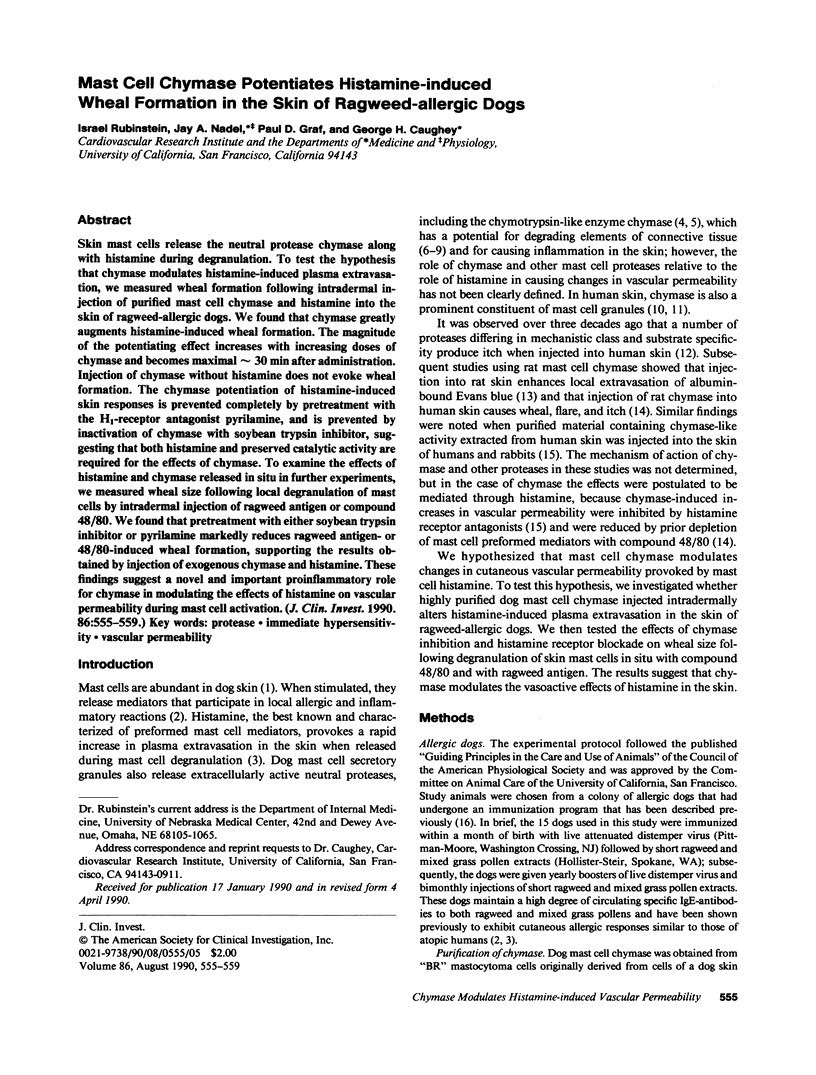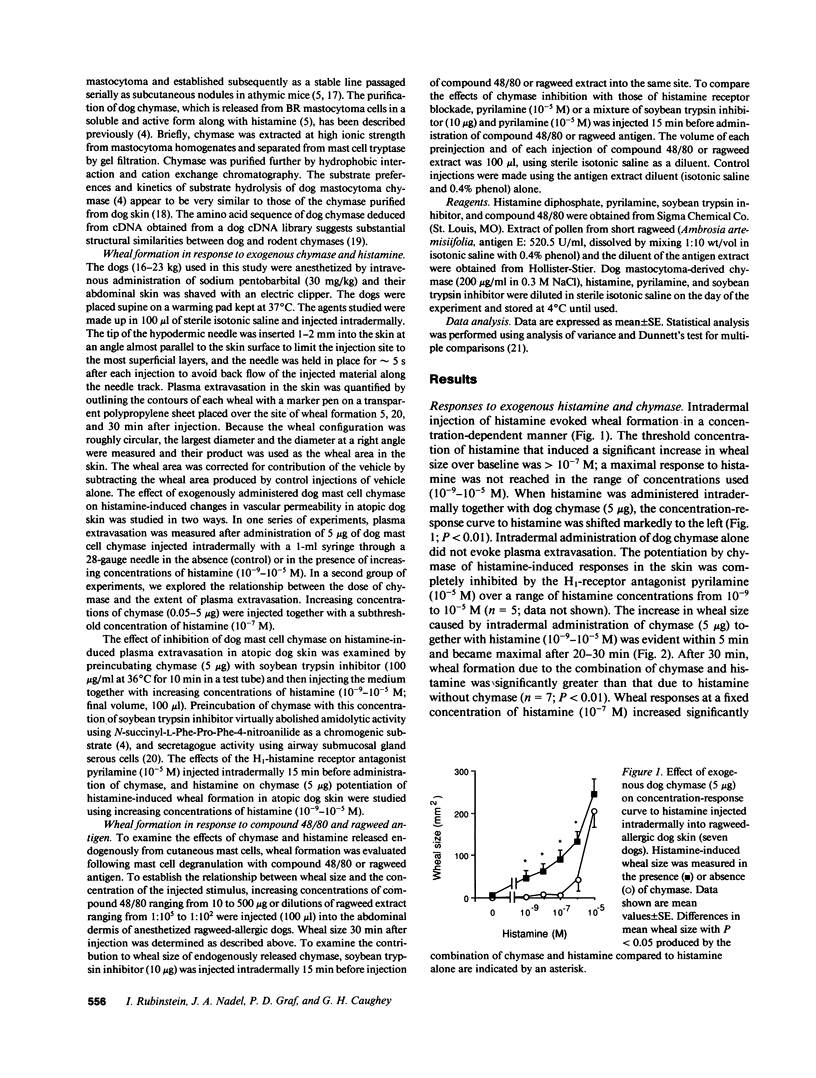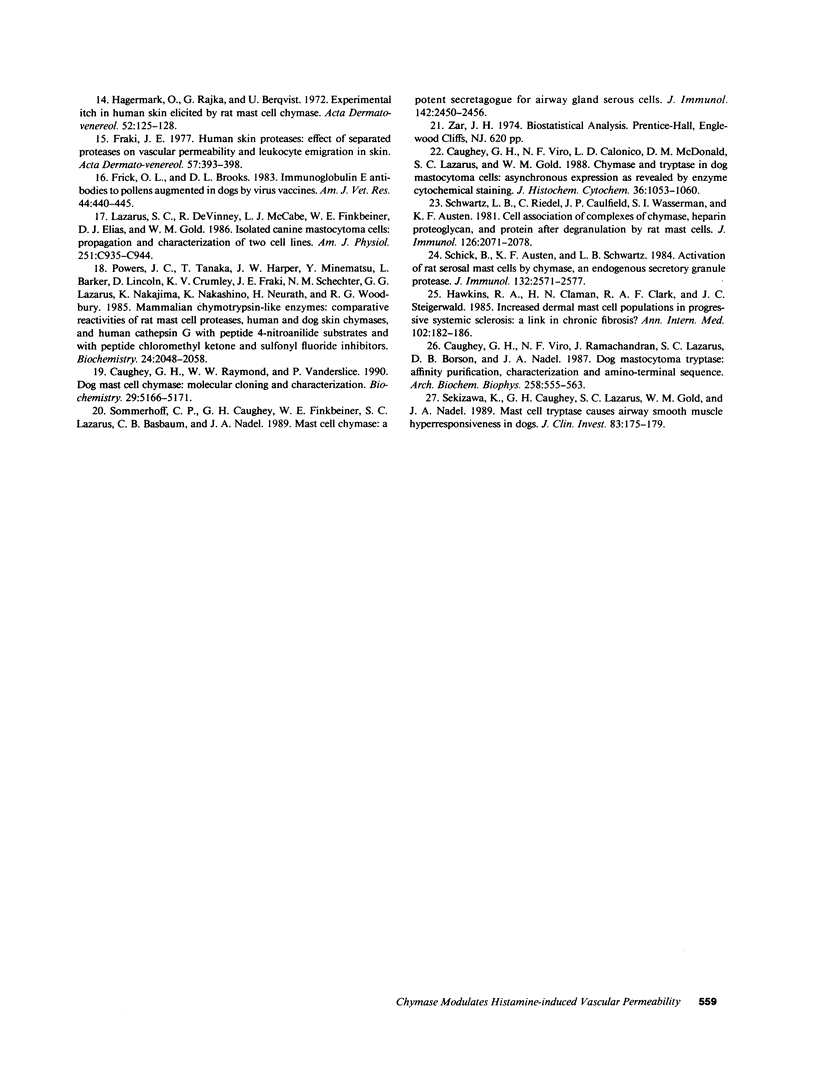Abstract
Skin mast cells release the neutral protease chymase along with histamine during degranulation. To test the hypothesis that chymase modulates histamine-induced plasma extravasation, we measured wheal formation following intradermal injection of purified mast cell chymase and histamine into the skin of ragweed-allergic dogs. We found that chymase greatly augments histamine-induced wheal formation. The magnitude of the potentiating effect increases with increasing doses of chymase and becomes maximal approximately 30 min after administration. Injection of chymase without histamine does not evoke wheal formation. The chymase potentiation of histamine-induced skin responses is prevented completely by pretreatment with the H1-receptor antagonist pyrilamine, and is prevented by inactivation of chymase with soybean trypsin inhibitor, suggesting that both histamine and preserved catalytic activity are required for the effects of chymase. To examine the effects of histamine and chymase released in situ in further experiments, we measured wheal size following local degranulation of mast cells by intradermal injection of ragweed antigen or compound 48/80. We found that pretreatment with either soybean trypsin inhibitor or pyrilamine markedly reduces ragweed antigen- or 48/80-induced wheal formation, supporting the results obtained by injection of exogenous chymase and histamine. These findings suggest a novel and important proinflammatory role for chymase in modulating the effects of histamine on vascular permeability during mast cell activation.
Full text
PDF




Selected References
These references are in PubMed. This may not be the complete list of references from this article.
- ARTHUR R. P., SHELLEY W. B. The role of proteolytic enzymes in the production of pruritus in man. J Invest Dermatol. 1955 Nov;25(5):341–346. doi: 10.1038/jid.1955.138. [DOI] [PubMed] [Google Scholar]
- Becker A. B., Chung F., McDonald D. M., Frick O. L., Gold W. M. Cutaneous allergic response in atopic dogs: relationship of cellular and histamine responses. J Allergy Clin Immunol. 1988 Feb;81(2):441–448. doi: 10.1016/0091-6749(88)90914-1. [DOI] [PubMed] [Google Scholar]
- Becker A. B., Chung K. F., McDonald D. M., Lazarus S. C., Frick O. L., Gold W. M. Cutaneous mast cell heterogeneity: response to antigen in atopic dogs. J Allergy Clin Immunol. 1986 Nov;78(5 Pt 1):937–942. doi: 10.1016/0091-6749(86)90243-5. [DOI] [PubMed] [Google Scholar]
- Becker A. B., Chung K. F., McDonald D. M., Lazarus S. C., Frick O. L., Gold W. M. Mast cell heterogeneity in dog skin. Anat Rec. 1985 Dec;213(4):477-80, 530-1. doi: 10.1002/ar.1092130402. [DOI] [PubMed] [Google Scholar]
- Briggaman R. A., Schechter N. M., Fraki J., Lazarus G. S. Degradation of the epidermal-dermal junction by proteolytic enzymes from human skin and human polymorphonuclear leukocytes. J Exp Med. 1984 Oct 1;160(4):1027–1042. doi: 10.1084/jem.160.4.1027. [DOI] [PMC free article] [PubMed] [Google Scholar]
- Caughey G. H., Lazarus S. C., Viro N. F., Gold W. M., Nadel J. A. Tryptase and chymase: comparison of extraction and release in two dog mastocytoma lines. Immunology. 1988 Feb;63(2):339–344. [PMC free article] [PubMed] [Google Scholar]
- Caughey G. H., Raymond W. W., Vanderslice P. Dog mast cell chymase: molecular cloning and characterization. Biochemistry. 1990 May 29;29(21):5166–5171. doi: 10.1021/bi00473a024. [DOI] [PubMed] [Google Scholar]
- Caughey G. H., Viro N. F., Calonico L. D., McDonald D. M., Lazarus S. C., Gold W. M. Chymase and tryptase in dog mastocytoma cells: asynchronous expression as revealed by enzyme cytochemical staining. J Histochem Cytochem. 1988 Aug;36(8):1053–1060. doi: 10.1177/36.8.3134486. [DOI] [PubMed] [Google Scholar]
- Caughey G. H., Viro N. F., Lazarus S. C., Nadel J. A. Purification and characterization of dog mastocytoma chymase: identification of an octapeptide conserved in chymotryptic leukocyte proteinases. Biochim Biophys Acta. 1988 Jan 29;952(2):142–149. doi: 10.1016/0167-4838(88)90109-4. [DOI] [PubMed] [Google Scholar]
- Caughey G. H., Viro N. F., Ramachandran J., Lazarus S. C., Borson D. B., Nadel J. A. Dog mastocytoma tryptase: affinity purification, characterization, and amino-terminal sequence. Arch Biochem Biophys. 1987 Nov 1;258(2):555–563. doi: 10.1016/0003-9861(87)90377-8. [DOI] [PubMed] [Google Scholar]
- Frick O. L., Brooks D. L. Immunoglobulin E antibodies to pollens augmented in dogs by virus vaccines. Am J Vet Res. 1983 Mar;44(3):440–445. [PubMed] [Google Scholar]
- Fräki J. E. Human skin proteases: effect of separated proteases on vascular permeability and leukocyte emigration in skin. Acta Derm Venereol. 1977;57(5):393–398. [PubMed] [Google Scholar]
- Hawkins R. A., Claman H. N., Clark R. A., Steigerwald J. C. Increased dermal mast cell populations in progressive systemic sclerosis: a link in chronic fibrosis? Ann Intern Med. 1985 Feb;102(2):182–186. doi: 10.7326/0003-4819-102-2-182. [DOI] [PubMed] [Google Scholar]
- Irani A. A., Schechter N. M., Craig S. S., DeBlois G., Schwartz L. B. Two types of human mast cells that have distinct neutral protease compositions. Proc Natl Acad Sci U S A. 1986 Jun;83(12):4464–4468. doi: 10.1073/pnas.83.12.4464. [DOI] [PMC free article] [PubMed] [Google Scholar]
- Lazarus S. C., DeVinney R., McCabe L. J., Finkbeiner W. E., Elias D. J., Gold W. M. Isolated canine mastocytoma cells: propagation and characterization of two cell lines. Am J Physiol. 1986 Dec;251(6 Pt 1):C935–C944. doi: 10.1152/ajpcell.1986.251.6.C935. [DOI] [PubMed] [Google Scholar]
- Powers J. C., Tanaka T., Harper J. W., Minematsu Y., Barker L., Lincoln D., Crumley K. V., Fraki J. E., Schechter N. M., Lazarus G. G. Mammalian chymotrypsin-like enzymes. Comparative reactivities of rat mast cell proteases, human and dog skin chymases, and human cathepsin G with peptide 4-nitroanilide substrates and with peptide chloromethyl ketone and sulfonyl fluoride inhibitors. Biochemistry. 1985 Apr 9;24(8):2048–2058. doi: 10.1021/bi00329a037. [DOI] [PubMed] [Google Scholar]
- Sage H., Woodbury R. G., Bornstein P. Structural studies on human type IV collagen. J Biol Chem. 1979 Oct 10;254(19):9893–9900. [PubMed] [Google Scholar]
- Sayama S., Iozzo R. V., Lazarus G. S., Schechter N. M. Human skin chymotrypsin-like proteinase chymase. Subcellular localization to mast cell granules and interaction with heparin and other glycosaminoglycans. J Biol Chem. 1987 May 15;262(14):6808–6815. [PubMed] [Google Scholar]
- Schick B., Austen K. F., Schwartz L. B. Activation of rat serosal mast cells by chymase, an endogenous secretory granule protease. J Immunol. 1984 May;132(5):2571–2577. [PubMed] [Google Scholar]
- Schwartz L. B., Riedel C., Caulfield J. P., Wasserman S. I., Austen K. F. Cell association of complexes of chymase, heparin proteoglycan, and protein after degranulation by rat mast cells. J Immunol. 1981 Jun;126(6):2071–2078. [PubMed] [Google Scholar]
- Sekizawa K., Caughey G. H., Lazarus S. C., Gold W. M., Nadel J. A. Mast cell tryptase causes airway smooth muscle hyperresponsiveness in dogs. J Clin Invest. 1989 Jan;83(1):175–179. doi: 10.1172/JCI113855. [DOI] [PMC free article] [PubMed] [Google Scholar]
- Seppä H. The role of chymotrypsin-like protease of rat mast cells in inflammatory vasopermeability and fibrinolysis. Inflammation. 1980 Mar;4(1):1–8. doi: 10.1007/BF00914098. [DOI] [PubMed] [Google Scholar]
- Seppä H., Vänänen K., Korhonen K. Effect of mast cell chymase of rat skin on intercellular matrix: a histochemical study. Acta Histochem. 1979;64(1):64–70. doi: 10.1016/S0065-1281(79)80053-7. [DOI] [PubMed] [Google Scholar]
- Sommerhoff C. P., Caughey G. H., Finkbeiner W. E., Lazarus S. C., Basbaum C. B., Nadel J. A. Mast cell chymase. A potent secretagogue for airway gland serous cells. J Immunol. 1989 Apr 1;142(7):2450–2456. [PubMed] [Google Scholar]
- Vartio T., Seppä H., Vaheri A. Susceptibility of soluble and matrix fibronectins to degradation by tissue proteinases, mast cell chymase and cathepsin G. J Biol Chem. 1981 Jan 10;256(1):471–477. [PubMed] [Google Scholar]


